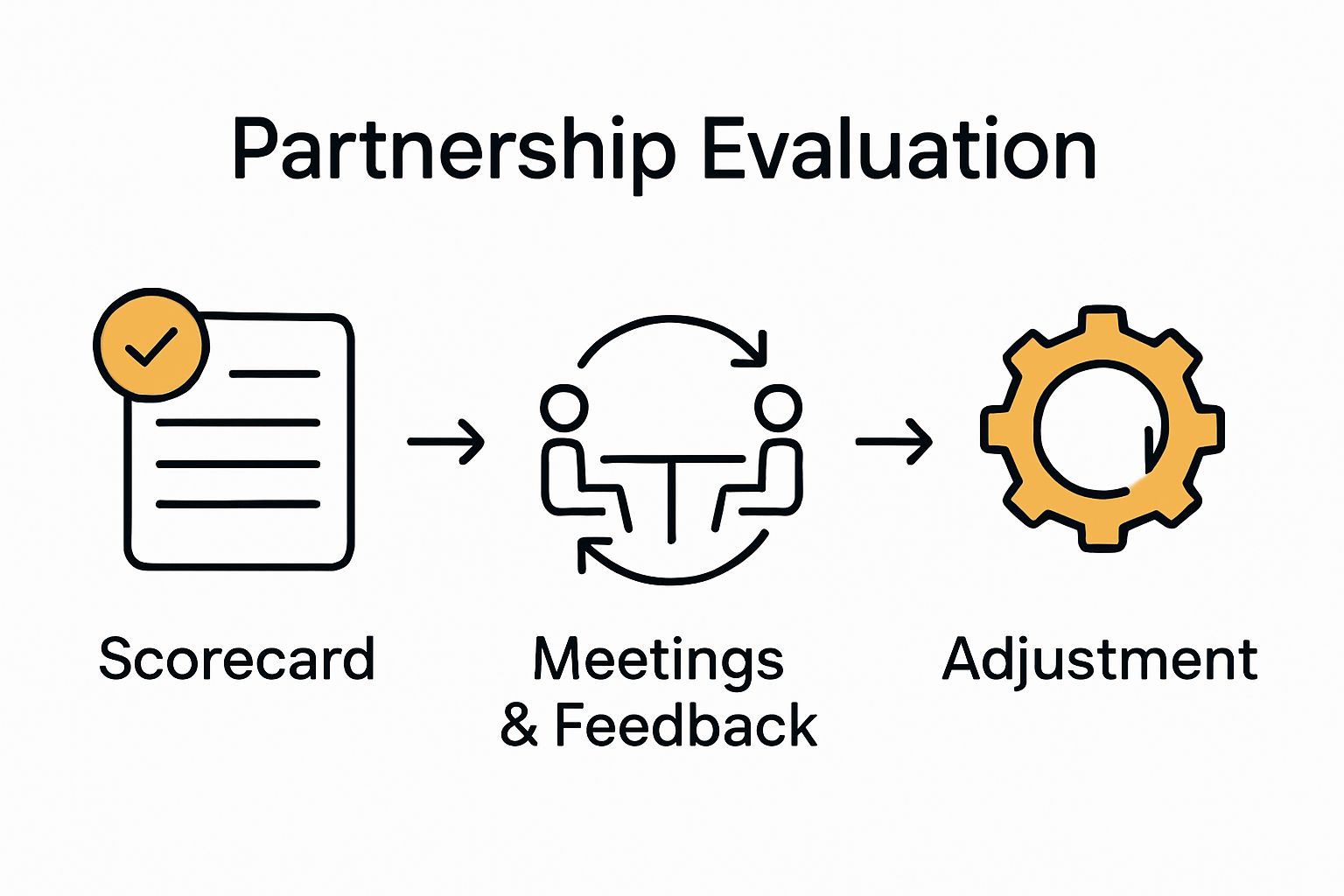Building a business partnership can sound straightforward. Shake hands, share goals, and get cracking. But the truth is, successful partnerships are built on deep alignment of mission and a proven track record of collaboration, not just a chat over coffee. Most businesses skip the serious groundwork and end up partnering with someone who looks right at first glance but misses the mark where it matters most.
Table of Contents
- Step 1: Identify Potential Partners Aligned With Goals
- Step 2: Conduct Outreach To Initiate Conversations
- Step 3: Develop A Value Proposition For Collaboration
- Step 4: Negotiate Terms And Define Roles Clearly
- Step 5: Create A Partnership Agreement To Formalize
- Step 6: Evaluate The Partnership’s Impact Regularly
Quick Summary
| Key Point | Explanation |
|---|---|
| 1. Identify compatible partners strategically | Assess your business goals to find partners that align with your mission and values, enhancing collaborative potential. |
| 2. Personalize outreach for engagement | Use tailored communication to initiate conversations, demonstrating genuine interest and understanding of potential partners. |
| 3. Create a measurable value proposition | Develop a clear proposition that outlines mutual benefits, measurable outcomes, and addresses partner concerns effectively. |
| 4. Negotiate with transparency and clarity | Establish a structured agreement that defines roles, responsibilities, and performance metrics to foster a long-term relationship. |
| 5. Regularly evaluate partnership success | Implement ongoing assessments of partnership performance to ensure alignment and identify opportunities for improvement. |
Step 1: Identify Potential Partners Aligned with Goals
Creating business partnerships requires strategic planning and a clear understanding of your growth objectives. The first crucial step involves meticulously identifying potential partners whose business goals, values, and market positioning complement your own strategic vision.
Begin by conducting a comprehensive internal assessment of your current business capabilities, market gaps, and specific growth targets. This self-evaluation helps you pinpoint exactly what type of partnership would provide maximum strategic advantage. Look beyond surface-level compatibility and focus on deep alignment in mission, operational approach, and long-term vision.
Research potential partners through multiple channels including industry networking events, professional associations, online business platforms, and targeted market research. Focus on businesses that demonstrate complementary strengths rather than direct competitors. For instance, a web design agency might seek partnerships with digital marketing firms, content creators, or software development companies that can enhance their service ecosystem.
During your partner identification process, develop a robust evaluation framework that considers several critical dimensions. Assess potential partners based on their market reputation, financial stability, technological capabilities, cultural compatibility, and demonstrated track record of successful collaborations. This multifaceted approach ensures you select partners who can genuinely contribute to your business growth.
Consider leveraging our guide on building marketing strategies to further refine your partnership identification approach. The key is to transform potential connections into strategic relationships that create mutual value and drive sustainable business expansion.
Successful partner identification involves persistent networking, thorough due diligence, and a willingness to invest time in understanding potential collaborators deeply. Your goal is not just to find a partner but to establish a meaningful business relationship that propels both organizations toward shared success.
Below is a step overview table summarising the main stages of creating business partnerships, along with their key objectives and suggested verification actions for small business owners.
| Step | Key Objective | Suggested Verification |
|---|---|---|
| 1. Identify Partners | Align missions and values with strategic growth targets | Use a robust evaluation framework to assess compatibility |
| 2. Conduct Outreach | Initiate personalised and meaningful conversations | Track outreach attempts and follow up regularly |
| 3. Develop Value Proposition | Highlight unique, measurable mutual benefits | Create a collaborative framework document outlining value creation |
| 4. Negotiate & Define Roles | Establish clear terms, roles, and dispute mechanisms | Finalise a detailed agreement covering contributions and metrics |
| 5. Formalise Agreement | Transform intent into a legally binding roadmap | Legal review and agreement signed by all parties |
| 6. Evaluate Impact | Ensure ongoing alignment and growth | Schedule regular reviews and document performance trends |
Step 2: Conduct Outreach to Initiate Conversations
After identifying potential business partners, the next critical phase involves strategically initiating meaningful conversations that transform initial interest into potential collaborative opportunities. Effective outreach requires a thoughtful, personalized approach that demonstrates genuine interest and professional credibility.
Craft a compelling initial communication strategy that goes beyond generic introductory emails. Your outreach should reflect deep research about the potential partner, highlighting specific ways your businesses could create mutual value. Personalise each communication by demonstrating specific knowledge about their company, recent achievements, or unique market positioning.
Leverage professional networking platforms and targeted communication channels to establish initial contact. LinkedIn provides an excellent professional context for initial connections, allowing you to explore mutual professional networks and shared industry connections. When reaching out, focus on creating a narrative that explains why a partnership makes strategic sense for both organizations.
Prepare a concise, impactful introduction package that includes a professional overview of your business, key collaboration potential, and a clear value proposition. This initial communication should be succinct, engaging, and focused on potential mutual benefits rather than a direct sales pitch. Include specific examples of how your businesses could complement each other’s strengths and generate additional value for both organizations.
Utilize warm introductions whenever possible. Professional referrals from mutual contacts significantly increase the likelihood of a positive initial response. Networking events, industry conferences, and shared professional associations can provide excellent opportunities for establishing these critical initial connections.
Explore our comprehensive marketing strategy guide to refine your communication approach and develop a structured outreach methodology. Remember that successful partnership initiation is about building genuine relationships, not transactional interactions.
Successful outreach requires persistence, professionalism, and a genuine commitment to creating meaningful business connections. Track your communication attempts, follow up professionally, and remain open to evolving conversations that might not immediately result in a partnership but could develop into valuable opportunities in the future.
Step 3: Develop a Value Proposition for Collaboration
Developing a robust value proposition represents the critical turning point in creating business partnerships. This step transforms initial conversations into a strategic framework that clearly articulates the mutual benefits and unique advantages of collaboration. Your value proposition must go beyond generic statements and demonstrate concrete, measurable outcomes that resonate with potential partners.
Begin by conducting a deep analysis of both your organization’s strengths and the potential partner’s strategic objectives. Identify specific ways your capabilities can directly address their business challenges or create new opportunities for growth. This requires a nuanced understanding of their market positioning, current limitations, and future expansion goals.
Construct a comprehensive value proposition that encompasses multiple dimensions of potential collaboration. Focus on creating a narrative that highlights tangible benefits such as expanded market reach, technological synergies, cost efficiencies, and complementary skill sets. Quantify potential impacts wherever possible by using projected metrics, estimated revenue increases, or specific performance improvements that could result from the partnership.
Ensure your value proposition addresses potential concerns and demonstrates a clear risk mitigation strategy. Potential partners will want to understand how the collaboration protects their existing business interests while creating new growth opportunities. Develop transparent mechanisms for shared decision making, intellectual property protection, and performance measurement.
Learn more about developing strategic marketing approaches to enhance your collaboration value proposition. The most compelling partnerships emerge from a genuine understanding of how two organizations can create something more powerful together than they could individually.
Critical verification for this step involves creating a detailed collaborative framework document that outlines specific value creation mechanisms. This document should clearly demonstrate how the partnership will generate mutual benefits, include preliminary performance indicators, and provide a roadmap for initial collaborative initiatives.
Successful value proposition development transforms theoretical potential into a concrete, actionable partnership strategy that excites and motivates both parties to move forward collaboratively.
Step 4: Negotiate Terms and Define Roles Clearly
Negotiating partnership terms represents a delicate process that requires strategic communication, transparency, and a commitment to mutual understanding. Successful negotiations transform potential collaboration into a structured, actionable agreement that protects both parties’ interests while creating pathways for shared success.
Initiate negotiations by creating a comprehensive framework document that outlines specific responsibilities, expected contributions, and performance metrics for each organization. This document should serve as a transparent roadmap, detailing exactly how each partner will contribute to the collaborative effort, including precise expectations around resource allocation, financial commitments, and operational responsibilities.
Prepare thoroughly by developing a clear understanding of your non-negotiable requirements and areas where you can demonstrate flexibility. Approach negotiations with a collaborative mindset that prioritizes long-term relationship building over short-term gains. This means being willing to compromise on tactical details while maintaining firm boundaries around core strategic objectives.
Carefully address potential areas of conflict by establishing clear communication protocols and dispute resolution mechanisms. Include specific clauses that outline how unexpected challenges will be managed, including processes for renegotiation, performance review, and potential partnership dissolution. These mechanisms demonstrate professional maturity and protect both parties from potential future misunderstandings.
Explore our comprehensive marketing strategy guide to gain additional insights into developing robust partnership frameworks. Effective negotiations require a balance between detailed documentation and maintaining a spirit of collaborative partnership.
Verification of successful negotiation involves creating a final partnership agreement that includes detailed documentation of:
- Specific roles and responsibilities for each organization
- Clear performance metrics and evaluation criteria
- Financial arrangements and resource commitment
- Communication and reporting protocols
- Mechanisms for ongoing partnership review and potential adjustment
The ultimate goal is to create a partnership agreement that feels like a collaborative opportunity rather than a restrictive contract.
 Successful negotiations transform potential business relationships into strategic alliances that generate genuine value for all participants.
Successful negotiations transform potential business relationships into strategic alliances that generate genuine value for all participants.
Step 5: Create a Partnership Agreement to Formalize
Formalizing a business partnership requires meticulous documentation that transforms verbal agreements into a legally binding and strategically comprehensive framework. The partnership agreement serves as the foundational blueprint that protects both parties’ interests while establishing clear expectations and collaborative mechanisms.
Consult with legal professionals specializing in business partnership agreements to ensure comprehensive coverage of all critical elements. Your agreement should go beyond standard legal language by creating a dynamic document that reflects the strategic vision and operational nuances of your collaborative relationship. Address potential scenarios including partnership expansion, performance challenges, and potential dissolution mechanisms.
Develop a comprehensive agreement that encompasses multiple dimensions of the partnership, including financial arrangements, intellectual property considerations, performance metrics, and communication protocols. The document should provide clear guidelines for:
- Specific financial contributions and revenue sharing models
- Detailed operational responsibilities for each organization
- Performance evaluation criteria and measurement mechanisms
- Conflict resolution processes
- Confidentiality and intellectual property protection clauses
Ensure the agreement maintains flexibility while providing structural integrity. Strategic partnerships require documents that can adapt to changing business environments without compromising core collaborative principles. Include provisions for periodic review and potential amendment, allowing the partnership to evolve organically as both organizations grow and transform.
Explore our strategic marketing approach guide to gain additional insights into developing robust partnership frameworks. A well-constructed partnership agreement becomes more than a legal document it becomes a strategic roadmap for mutual success.
Here is a checklist table outlining key elements to include in your partnership agreement, helping ensure all critical areas are covered for a robust and adaptable collaboration.
| Agreement Element | Why It Matters | Completion Status |
|---|---|---|
| Financial Contributions | Clarifies how each partner invests and profits | [ ] |
| Operational Responsibilities | Ensures everyone knows their duties | [ ] |
| Performance Metrics | Makes progress and success measurable | [ ] |
| Communication Protocols | Keeps information flowing efficiently | [ ] |
| Dispute Resolution Process | Prepares for disagreements or changes | [ ] |
| IP & Confidentiality Clauses | Safeguards key assets and information | [ ] |
| Review & Amendment Terms | Allows the agreement to evolve as needed | [ ] |
Verification of a successful partnership agreement involves a comprehensive review process where both parties carefully evaluate every clause, ensuring complete understanding and alignment. The final document should reflect a genuine collaborative spirit, demonstrating mutual respect, shared objectives, and a commitment to creating value beyond individual organizational boundaries. Successful formalization transforms potential partnerships into powerful strategic alliances that can drive significant business growth.
Step 6: Evaluate the Partnership’s Impact Regularly
Regular partnership evaluation represents the critical mechanism for ensuring continued strategic alignment and driving sustainable business growth. Implementing a structured, objective assessment process transforms partnerships from static agreements into dynamic, evolving collaborative relationships that consistently generate value for both organizations.
Establish a comprehensive evaluation framework that encompasses multiple performance dimensions. This approach goes beyond simple financial metrics to include qualitative assessments of strategic compatibility, operational efficiency, innovation potential, and mutual value creation. Create a balanced scorecard that captures both quantitative performance indicators and nuanced collaborative outcomes.
Schedule regular review meetings that provide structured opportunities for transparent dialogue about partnership performance. These sessions should include detailed data analysis, open discussions about challenges and opportunities, and collaborative problem-solving. Develop a rhythm of quarterly comprehensive reviews supplemented by monthly check-ins to maintain ongoing communication and momentum.
Utilize advanced tracking tools and performance management systems to gather objective data about partnership impact. Implement key performance indicators that measure:
- Revenue generated through collaborative efforts
- Cost efficiencies achieved
- Market expansion capabilities
- Innovation metrics
- Customer satisfaction improvements
Explore our strategic marketing methodology guide to enhance your partnership evaluation approach. Effective assessment requires a holistic view that recognizes both quantitative performance and strategic alignment.
Successful partnership evaluation involves creating a feedback loop that allows for continuous adjustment and improvement. Be prepared to renegotiate terms, realign strategies, or potentially restructure the partnership based on performance insights. The most successful business collaborations remain flexible, responsive, and committed to mutual growth.
Verification of effective partnership evaluation includes documentation of performance trends, actionable insights generated from review processes, and concrete strategic adjustments implemented as a result of ongoing assessment. Your goal is to transform partnership evaluation from a compliance exercise into a strategic tool for continuous improvement and shared success.

Turn Your Strategic Partnerships Into Real Business Growth with Zoo Digital
You have just discovered how crucial it is to build business partnerships that align with your vision. But even after identifying partners and setting up agreements, many small businesses struggle to actually unlock the promised value. Are gaps in tracking, campaign execution, or communication standing in your way of scaling those collaborations and reaching your growth targets?

At Zoo Digital, our data driven marketing expertise can transform your partnerships into measurable results. We set up professional tracking systems, automate lead management, and run campaigns on Google, Meta, and TikTok. Drive more leads from every alliance and prove ROI with robust analytics. Visit our main site today and let us be the link that turns your next business relationship into tangible success. Growing your network means nothing unless it fuels your bottom line. Reach out now to level up your partnerships.
Frequently Asked Questions
What are the first steps to creating business partnerships for small business growth?
Creating business partnerships begins with identifying potential partners whose goals and values align with your business. Start by conducting an internal assessment of your capabilities and market gaps, then research different businesses that complement your strengths.
How do I effectively reach out to potential business partners?
To effectively reach out, personalize your communication by highlighting specific ways your businesses could collaborate. Use professional networking platforms like LinkedIn and prepare a concise introduction package that outlines your business and the mutual benefits of a partnership.
What should I include in a value proposition for a partnership?
A value proposition should detail how the partnership can create mutual benefits such as increased market reach or cost efficiencies. Focus on quantifying potential impacts or improvements that resonate with your potential partner’s objectives.
What key terms should be included in a partnership agreement?
A partnership agreement should clearly define roles, financial contributions, and performance metrics for each organization. Additionally, include communication protocols and mechanisms for conflict resolution, ensuring both parties’ interests are protected.
How can I evaluate the impact of a business partnership?
Evaluate a partnership’s impact by establishing a comprehensive framework that includes both quantitative metrics like revenue generated and qualitative assessments of alignment and value creation. Regularly schedule review meetings to discuss performance and make adjustments as necessary.
What are the benefits of forming partnerships for small businesses?
Forming partnerships can lead to expanded market reach, shared resources, and improved operational efficiencies. Collaborating with another business can create a network of support and increase the potential for innovation, driving growth for both organizations.

